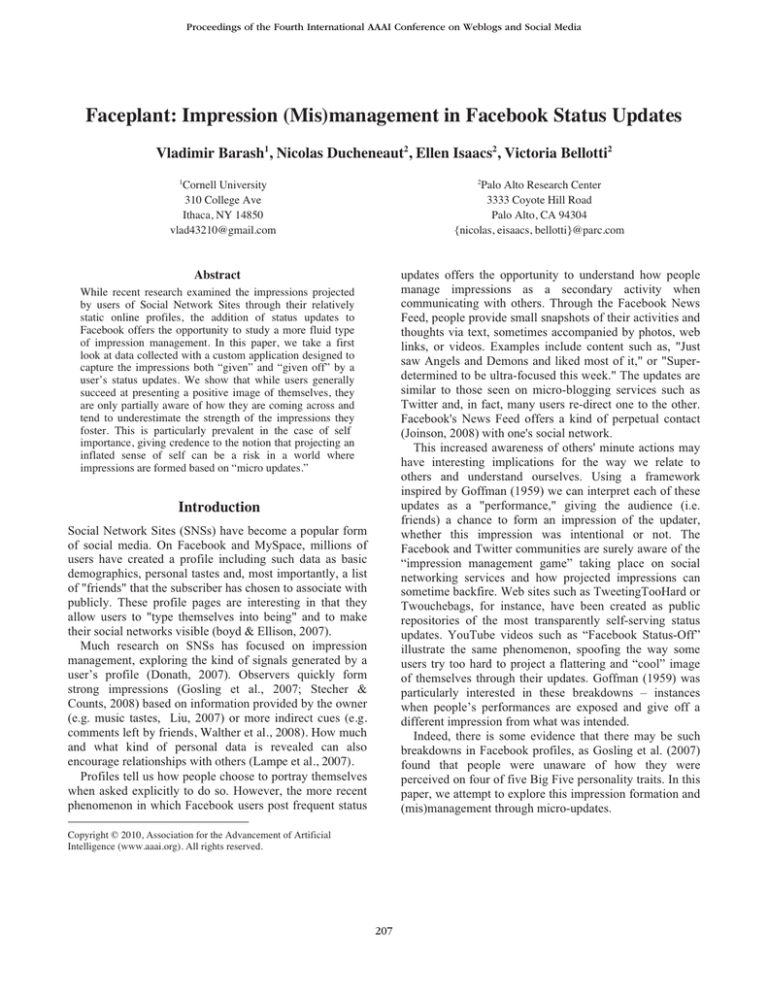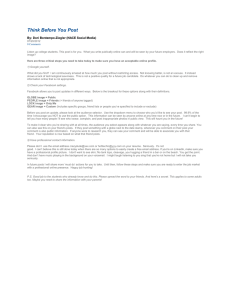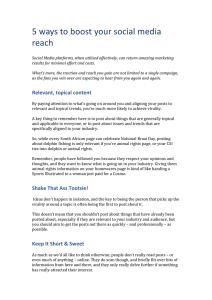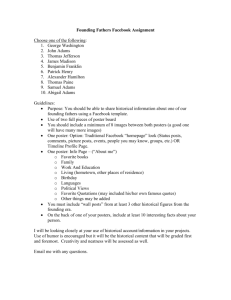
Proceedings of the Fourth International AAAI Conference on Weblogs and Social Media
Faceplant: Impression (Mis)management in Facebook Status Updates
Vladimir Barash1, Nicolas Ducheneaut2, Ellen Isaacs2, Victoria Bellotti2
1
2
Cornell University
310 College Ave
Ithaca, NY 14850
vlad43210@gmail.com
Palo Alto Research Center
3333 Coyote Hill Road
Palo Alto, CA 94304
{nicolas, eisaacs, bellotti}@parc.com
updates offers the opportunity to understand how people
manage impressions as a secondary activity when
communicating with others. Through the Facebook News
Feed, people provide small snapshots of their activities and
thoughts via text, sometimes accompanied by photos, web
links, or videos. Examples include content such as, "Just
saw Angels and Demons and liked most of it," or "Superdetermined to be ultra-focused this week." The updates are
similar to those seen on micro-blogging services such as
Twitter and, in fact, many users re-direct one to the other.
Facebook's News Feed offers a kind of perpetual contact
(Joinson, 2008) with one's social network.
This increased awareness of others' minute actions may
have interesting implications for the way we relate to
others and understand ourselves. Using a framework
inspired by Goffman (1959) we can interpret each of these
updates as a "performance," giving the audience (i.e.
friends) a chance to form an impression of the updater,
whether this impression was intentional or not. The
Facebook and Twitter communities are surely aware of the
“impression management game” taking place on social
networking services and how projected impressions can
sometime backfire. Web sites such as TweetingTooHard or
Twouchebags, for instance, have been created as public
repositories of the most transparently self-serving status
updates. YouTube videos such as “Facebook Status-Off”
illustrate the same phenomenon, spoofing the way some
users try too hard to project a flattering and “cool” image
of themselves through their updates. Goffman (1959) was
particularly interested in these breakdowns – instances
when people’s performances are exposed and give off a
different impression from what was intended.
Indeed, there is some evidence that there may be such
breakdowns in Facebook profiles, as Gosling et al. (2007)
found that people were unaware of how they were
perceived on four of five Big Five personality traits. In this
paper, we attempt to explore this impression formation and
(mis)management through micro-updates.
Abstract
While recent research examined the impressions projected
by users of Social Network Sites through their relatively
static online profiles, the addition of status updates to
Facebook offers the opportunity to study a more fluid type
of impression management. In this paper, we take a first
look at data collected with a custom application designed to
capture the impressions both “given” and “given off” by a
user’s status updates. We show that while users generally
succeed at presenting a positive image of themselves, they
are only partially aware of how they are coming across and
tend to underestimate the strength of the impressions they
foster. This is particularly prevalent in the case of self
importance, giving credence to the notion that projecting an
inflated sense of self can be a risk in a world where
impressions are formed based on “micro updates.”
Introduction
Social Network Sites (SNSs) have become a popular form
of social media. On Facebook and MySpace, millions of
users have created a profile including such data as basic
demographics, personal tastes and, most importantly, a list
of "friends" that the subscriber has chosen to associate with
publicly. These profile pages are interesting in that they
allow users to "type themselves into being" and to make
their social networks visible (boyd & Ellison, 2007).
Much research on SNSs has focused on impression
management, exploring the kind of signals generated by a
user’s profile (Donath, 2007). Observers quickly form
strong impressions (Gosling et al., 2007; Stecher &
Counts, 2008) based on information provided by the owner
(e.g. music tastes, Liu, 2007) or more indirect cues (e.g.
comments left by friends, Walther et al., 2008). How much
and what kind of personal data is revealed can also
encourage relationships with others (Lampe et al., 2007).
Profiles tell us how people choose to portray themselves
when asked explicitly to do so. However, the more recent
phenomenon in which Facebook users post frequent status
Copyright © 2010, Association for the Advancement of Artificial
Intelligence (www.aaai.org). All rights reserved.
207
•
•
•
Measuring Micro Impression Management
While the work of Goffman provides a well-established
metaphor (stage and audience) for understanding
impression management, it remains surprisingly vague
about the dimensions that constitute an impression in
practice. In his essay, “On Face Work” (Goffman, 1963),
face is defined as “the positive social value a person
effectively claims for himself by the line others assume he
has taken during a particular contact. […] It is an image of
self, delineated in terms of approved social attributes.” Yet
Goffman did not provide a list of tactics people use during
face-work, or a taxonomy of impression formation.
Nevertheless, others have attempted to characterize the
dimensions of impression management. Examples include
the work of Jones and Pittman (1982), which defines five
tactics used during face-work: ingratiation, intimidation,
self-promotion, exemplification (appearing virtuous), and
supplication (looking weak to engender help). McClelland
(1988) offered three basic social motivations: power,
affiliation, and achievement, and Leary (1995) posited that
people are motivated to be seen as physically attractive,
likeable, competent, capable, and virtuous.
Our initial inclination was to adopt one of these
taxonomies to characterize face-work on Facebook. Upon
initial examination of the authors’ own News Feeds,
however, most of the dimensions did not seem to apply to
most updates. For example, how does one rate “Mango
pancakes are super yummy! Next culinary venture: mango
salsa” in terms of its attempt to demonstrate power or
achievement, let alone ingratiation or supplication?
Further, all posts scored high on affiliation because posting
an update is in itself an attempt to connect with others.
This disparity between posts and existing frameworks for
face-work underscored Goffman’s insistence on the
contextuality of impression management. To proceed we
needed to find a set of dimensions that would apply to the
type of micro-updates presented on Facebook.
Consequently, we ran an initial pilot study with over 20
Facebook users asking them to characterize the
impressions they formed of their friends’ News Feed
updates, using any adjective they liked. The data were
collected through a simple Facebook application providing
a text box for the adjective next to each status update,
allowing subjects to rate the posts in context. Following
principles from Grounded Theory (Glaser, 1998), the
authors constructed a list of high-level categories that
characterized the principal dimensions collected. Based on
Goffman’s earlier definition of face-work, these
dimensions were binary to capture the notion of “positive
social value” claimed by the post author vs. the
corresponding negative value (which can be seen as a
“failed” impression). The dimensions were:
•
•
Uplifting – Depressing
Self-deprecating – Self-important
Appreciative – Critical
We do not claim that these dimensions capture the full
diversity of face-work on Facebook, but they did capture
the impressions our subjects believed to be “given” and
“given off” in most status updates, as we describe in our
next section. It is worth noting that this bottom-up
approach yielded only one category – self-importance –
that mapped well to the theory-based taxonomies.
We then used these dimensions to evaluate the
alignment between the impressions people intend to give
off with the impressions others form of them. We did so by
asking people to indicate their impressions of their own
and others’ status updates using a custom-built Facebook
application, and by tracking the naturally occurring
responses to those posts. Facebook provides two ways to
respond to a post: by adding a text comment and by
clicking a “thumbs up” symbol to indicate one “likes” a
post. Beyond the data generated by our application, we
also looked at which types of posts received more
comments and more “likes.”
Figure 1. Screenshot of "Rate Your News Feed"
Methods
Our “Rate Your News Feed” application presented users
with a list of posts from their News Feed, including their
own and their friends' posts. Each post was accompanied
by a picture of the poster, that person’s name, and the text
of the post. No likes or comments were displayed with the
post, so as not to bias people’s perceptions of the post.
Beneath each post was a set of five sliders, one for each of
our five dimensions of impression management, plus a text
box asking for an adjective to describe how the person
“came across” in that post (see Figure 1). The latter was
included in case our categories did not fully capture the
performance projected in a given post. The sliders were set
in the middle between the two adjectives and no numbers
were associated with the end points. After rating five posts,
users could ask to rate another page of posts or they could
submit their ratings. Doing the latter took them to a page
showing the dimensions on which their friends’ posts
deviated most from the norm, along with humorous
cartoons comparing their friends to characters such as
House on the popular TV show (for especially selfimportant posts) or Mary Poppins (uplifting).
Cool – Uncool
Entertaining – Boring
208
binomial tests to determine statistical significance. As
shown in Figure 2, on average people viewed others’ posts
positively on all the dimensions except one. They thought
others came across as significantly more cool than uncool,
more entertaining than boring, more uplifting than
depressing, and more appreciative than critical, but they
also saw them as more self-important than self-deprecating
[p<.05]. When judging their own posts, however, they saw
themselves only as significantly more appreciative than
critical [p<.01]. Self-ratings on the other four dimensions
showed the same pattern as the other-ratings, but none of
the differences were statistically significant. The data for
self-ratings was fairly sparse, so more data would tell us
whether this pattern would hold up.
Results
We collected data from 100 participants over 21 days,
resulting in 674 rated updates. Out of these updates 575
were for other people’s status updates and 99 were for the
participants’ own posts. There were relatively few posts
(30) for which we collected both the participant’s ratings
and at least one friend’s rating of that same post.
Therefore, in most of these analyses we aggregate ratings
of users’ own posts and ratings of friends’ posts,
understanding that they are generally not ratings of the
same posts. We performed preliminary analysis with the
posts for which we had both the user’s rating and the rating
of at least one friend, and found qualitatively the same
results as with aggregate ratings, but without statistical
significance due to the small sample size.
Relevance of Dimensions
Since the sliders all started in the middle (indicating the
dimension did not apply to the post), we looked at the
number of updates for which raters moved at least one
slider to get a sense of the applicability of our dimensions.
Participants rated 71% of their friends’ posts along at least
one dimension, and among the remaining posts they added
their own adjective only 3.5% of the time. This result
indicates that these dimensions generally captured people’s
impressions of most types of Facebook status updates.
Interestingly, users rated only 45% of their own posts on at
least one dimension, and added their own adjectives to
only 5.7% of the remaining 55%. This gives us an initial
indication that there may be a gap between the impressions
people believe themselves to be giving off and the
impressions they form of others.
The dimension that was seen as most relevant to friends’
posts was Entertaining–Boring (rated in 47% of the posts),
followed by Cool–Uncool (38%), Appreciative–Critical
(35%), Uplifting–Depressing (34%) and Self-Important–
Self-Deprecating (28%). When rating oneself, CoolUncool was most often seen as relevant (35%), with all the
other dimensions being rated between 28% and 24% of the
time. Since the dimensions seen as most relevant were
Entertaining–Boring and Cool–Uncool, the positive ends
of those spectra may capture some of “the positive social
value a person effectively claims for himself” (Goffman,
1963) in the context of Facebook. Put differently, seeing a
lot of “cool” and “entertaining” updates could shape a
user’s perception of what constitutes “successful” facework on Facebook.
Figure 2. Proportion of positive and negative ratings for one’s
own and for others’ posts (* = p<.05; # = p<.01).
Overall it appears that people were generally successful
at projecting a positive image of themselves except for a
tendency to come across as self-important. Examples of
adjectives people added to characterize others’ posts
include “showing off,” “snobby,” “proud” and
“overachiever.” The self-rating data suggest that, while
people believed they were portraying themselves as
appreciative, they were not as aware of the impressions
they were creating along the other dimensions.
Next, we wanted to see if people had a sense of the
degree to which they were giving off these impressions.
We looked at the proportion of positive to negative ratings
along each dimension when rating self and others.
Although people were aware they were coming across as
more
self-important
than
self-deprecating,
they
underestimated the degree to which this was so (see Figure
2) [p<.05]. Similarly, although they accurately believed
themselves to be coming off as appreciative, they
overestimated the degree to which this was so [p<.05].
There were no significant differences between self and
other ratings on the remaining dimensions.
Alignment of Impressions Given vs. Given Off
The crux of our interest is the degree to which the
impressions people think they are giving are aligned with
the impressions others form of them. We started to explore
this question by comparing how people rated themselves
vs. others on the five dimensions. In all analyses, we used
Face-work that Provokes a Response
We were also interested to see which types of posts were
more likely to provoke a response via text comments and
“likes” ratings. As shown in Figure 3, posts that were seen
209
as entertaining were significantly more likely than boring
ones to provoke comments [p<.01], and posts seen as
depressing generated comments more often than uplifting
ones [p<.01]. The other dimensions did not have a
significant effect on commenting. We found no pattern in
the types of posts that garnered “likes” votes.
Subjective experience with Facebook suggests these
results could reflect two common commenting patterns: the
phatic (Schneider, 1998) “ha ha” or “hilarious!” often seen
after an amusing message, or offers of sympathy like “poor
you” or “that’s terrible” offered after a participant
announces bad news. The “laughs” generated by
entertaining updates also illustrate how being funny is one
of the “approved social attributes” (Goffman, 1963) that
participants want to reinforce through explicit positive
feedback in the context of Facebook.
References
boyd, d., & Ellison, N. B. (2007). Social network sites:
Definition, history, and scholarship. Journal of ComputerMediated Communication, 13(1).
Canny, J., Cole, R. E., Sack, W., & Weber, S. (2001). ITR:
Open Source software development and learning.
Donath, J. (2007). Signals in social supernets. Journal of
Computer-Mediated Communication, 13(1).
Garzarelli, G. (2001). Open source software and the
economics of organization. In Proceedings of the third
annual conference of the association of historians of the
Austrian tradition in economic thought (pp. 22). Lucca, 2426 May 2001.
Glaser, B. G. (1998). Doing grounded theory: issues and
discussions. Mill Valley, CA: Sociology Press.
Goffman, E. (1959). The presentation of self in everyday
life. Garden City, New York: Doubleday.
Goffman, E. (1963). On Face-Work. In Interaction Ritual.
New York: Anchor Books.
Gosling, S., Gaddis, S., & Vazire, S. (2007). Personality
impressions based on Facebook profiles. In Proceedings of
ICWSM 2007.
Joinson, A. N. (2008). 'Looking up' or 'Keeping up with'
people? Motives and uses of Facebook. In Proceedings of
CHI 2008 (pp. 1027-1036).
Jones, E. E., & Pittman, T. S. (1982). Toward a general
theory of strategic self-presentation. In J. Suls (Ed.),
Psychological perspectives of the self (pp. 231-262).
Hillsdale, NJ: Erlbaum.
Lampe, C., Ellison, N., & Steinfield, C. (2007). A familiar
face(book): profile elements as signals in an online social
network. In Proceedings of CHI 2007 (pp. 435-444).
Leary, M. (1995). Self-presentation: Impresssion
management and interpersonal behavior: Westview Press.
Liu, H. (2007). Social network profiles as taste
performances. Journal of Computer-Mediated
Communication, 13(1).
Madanmohan, T. R., & Navelkar, S. (2002). Roles and
knowledge management in online technology communities:
an ethnographic study: India Institute of Management,
Bagalore (IIMB).
McClelland, D. (1988). Human Motivation. Cambridge:
Cambridge University Press.
Schneider, K. (1998). Small talk: Analysing phatic
discourse. Marburg: Hitzeroth.
Stecher, K. B., & Counts, S. (2008). Thin Slices of Online
Profile Attributes. In Proceedings of ICWSM'2008.
Walther, J. B., Van Der Heide, B., Kim, S.-Y., Westerman,
D., & Tong, S. T. (2008). The role of friends’ appearance
and behavior on evaluations of individuals on facebook:
Are we known by the company we keep? Human
Communication Research, 34, 28-49.
Figure 3. Probability of receiving at least one comment, based
on the impression given (# indicates p<.01).
Conclusion
While limited in scope, these initial analyses shed some
light on the kind of “impression management game”
played through Facebook status updates. The prevalence of
cool and entertaining updates suggests these dimensions as
highly relevant to successful face-work on SNSs, which is
reinforced by their tendency to attract more comments than
other types of posts. While users strive (and often succeed)
to project a positive image along these dimensions, they
underestimate how much certain updates make them look
self-important. This finding is well-aligned with a common
perception that updates can go “too far” and project a selfaggrandizing image that clashes with the light-hearted
tone of most SNSs. People also believe their posts express
appreciation more than their friends perceive. In a world of
perpetual contact (Joinson, 2008) where people form quick
and long-lasting impressions of others (Gosling et al.,
2007; Stecher & Counts, 2008) our data show that users,
now more than ever, need to walk a fine line between the
impressions they “give” and inadvertently “give off”
(Goffman, 1959).
210





